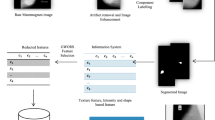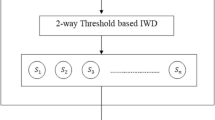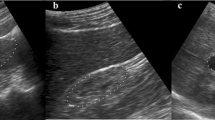Abstract
Ultrasound imaging is the most suitable method for early detection of prostate cancer. It is very difficult to distinguish benign and malignant nature of the affliction in the early stage of cancer. This is reflected in the high percentage of unnecessary biopsies that are performed and many deaths caused by late detection or misdiagnosis. A computer based classification system can provide a second opinion to the radiologists. Generally, objects are described in terms of a set of measurable features in pattern recognition. The selection and quality of the features representing each pattern will have a considerable bearing on the success of subsequent pattern classification. Feature selection is a process of selecting the most wanted or dominating features set from the original features set in order to reduce the cost of data visualization and increasing classification efficiency and accuracy. The region of interest (ROI) is identified from transrectal ultrasound (TRUS) images using DBSCAN clustering with morphological operators after image enhancement using M3-filter. Then the 22 grey level co-occurrence matrix features are extracted from the ROIs. Soft computing model based feature selection algorithms genetic algorithm (GA), ant colony optimization (ACO) and QR are studied. In this paper, QR-ACO (hybridization of rough set based QR and ACO) and GA-ACO (hybridization GA and ACO) are proposed for reducing feature set in order to increase the accuracy and efficiency of the classification with regard to prostate cancer. The selected features may have the best discriminatory power for classifying prostate cancer based on TRUS images. Support vector machine is tailored for evaluation of the proposed feature selection methods through classification. Then, the comparative analysis is performed among these methods. Experimental results show that the proposed method QR-ACO produces significant results. Number of features selected using QR-ACO algorithm is minimal, is successful and has high detection accuracy.










Similar content being viewed by others
References
Acampora G, Lee C-S, Vitiello A, Wang M-H (2012) Evaluating cardiac health through semantic soft computing techniques. Soft Comput 16(7):1165–1181
Al-Ani A (2005) Feature subset selection using ant colony optimization. Int J Comput Intell 2:53–58
Alpigini JJ, Peters JF, Skowronek J, Zhong N (eds) (2002) Rough sets and current trends in computing. In: Proceedings of the third international conference, lecture notes in computer science 2475, Springer, New York
Beligiannis G, Hatzilygeroudis I, Koutsojannis C, Prentzas J (2006) A GA driven intelligent systemfor medical diagnosis. Lecture Notes in Computer Science (including subseries Lecture Notes in Artificial Intelligence and Lecture Notes in Bioinformatics) 4251 LNAI-I, pp 968–975
Bins J, Draper BA (2001) Feature selection from huge feature sets. In: Proceedings of the eighth IEEE international conference on computer vision, ICCV 2001, vol 2, pp 159–165
Couceiro MS, Rocha RP, Ferreira NMF, Machado JAT (2012) Introducing the fractional-order Darwinian PSO. Signal Image Video Process 6(3):343–350 (Springer-Verlag)
De Falco I (2011) A differential evolution-based system supporting medical diagnosis through automatic knowledge extraction from databases. In: IEEE international conference on bioinformatics and biomedicine (BIBM), institute of high performance computing and networking, national research council of Italy (ICAR-CNR), Naples, Italy, 12–15 Nov 2011, pp 321–326
Devendran V et al (2008) Texture based scene categorization using artificial neural networks and support vector machines: a comparative study. ICGST-GVIP 8(IV):45–52
Goldberg D (1989) Genetic algorithms in search, optimization and machine learning, 1st edn. Addison Wesley, USA
Jensen R, Shen Q (2008) Computational intelligence and feature selection: rough and fuzzy approaches. Wiley, New york
John GH, Kohavi R, Pfleger K (1994) Irrelevant features and the subset selection problem. In: Proceedings of the 11th international conference on, machine learning, pp 121–129
Kostek B (1999) Soft computing in acoustics: applications of neural networks. Fuzzy logic and rough sets to musical acoustics. Physica-Verlag, Heidelberg
Li G-Z, Meng H-H, Yang MQ, Yang JY (2009) Combining support vector regression with feature selection for multivariate calibration. Neural Comput Appl Springer 18(7):813–820
Lin TY, Cercone N (1997) Rough sets and data mining: analysis of imprecise data. Kluwer Academic Publishers, Dordrecht
Liu H, Motoda H (eds) (1998) Feature extraction construction and selection: a data mining perspective. Kluwer international series in engineering and computer science. Kluwer Academic Publishers, Dordrecht
Manavalan R, Thangavel K (2011a) Evaluation of textural feature extraction methods for prostate cancer TRUS medical images. Int J Comput Appl 36(12):33–39
Manavalan R, Thangavel K (2011b) TRUS image segmentation using morphological operators and DBSCAN clustering. In: Proceedings of the world congress on information and communication technologies (WICT), pp 898–903, 11–14 Dec 2011
Manavalan R, Thangavel T (2012) Comparative analysis of feature extraction methods for the classification of prostate cancer from TRUS medical images. IJCSI Int J Comput Sci Issues 9[1(2)]
Mantzaris D, Anastassopoulos G, Iliadis L, Adamopoulos A (2009) An evolutionary technique for medical diagnostic risk factors selection. Artif Intell Appl Innov III, IFIP Int Fed Inf Process 296:195–203
Di Martino F, Loia V, Sessa S (2010) Fuzzy transforms method and attribute dependency in data analysis. Inf Sci 180(4):493–505
Mishra D, Rath AK, Acharya M, Jena T (2009) Rough ACO: a hybridized model for feature selection in gene expression data. Int J Comput Commun Technol 1(1):85–98
Modrzejewski M (1993) Feature selection using rough sets theory. In: Proceedings of the 11th international conference on machine learning, pp 213–226
Othman AA, Tizhoosh HR (2011) Evolving fuzzy image segmentation. In: Proceedings of the IEEE International Conference on Fuzzy Systems (FUZZ), pp 1603–1609, 27–30 June 2011
Pawlak Z (1982) Rough sets. Int J Comput Inf Sci 11(5):341–356
Rashidy Kanan H, Faez K (2008) An improved feature selection method based on ant colony optimization (ACO) evaluated on face recognition system. Appl Math Comput 205:716–725
Sheikhan M, Mohammadi N (2011) Neural-based electricity load forecasting using hybrid of GA and ACO for feature selection, neural computing and applications. Springer verlag London Limited, Guildford
Thangavel K, Karnan M, Pethalakshmi A (2005) Performance analysis of rough reduct algorithms in mammograms. Int J Graph Vis Image Process 8:13–21
Thangavel K, Manavalan R, Laurence Aroquiaraj I (2009) Removal of speckle noise from ultrasound medical image based on special filters: comparative study. ICGST Int J Graph Vis Image Process GVIP 09(3):25–32
Vapnik V (1995) The nature of statistical learning theory, chapter 5. Springer, New York
Vapnik V (1998) Statistical learning theory. Wiley, New York
Wu T, Xie K, Nie C, Song G (2012) An adaption of relief for redundant feature elimination. Advances in neural networks. Springer, Berlin, pp 73–81
Yang C-H, Shih T-M, Chuang L-Y (2009) Reducing SAGE data using genetic algorithms. Int J Inf Math Sci 5(4):268–272
Acknowledgments
The present work is supported by Special Assistance Programme of University Grants Commission, New Delhi, India [Grant No. F.3-50/2011(SAP-II)].
Author information
Authors and Affiliations
Corresponding author
Additional information
Communicated by V. Loia.
Rights and permissions
About this article
Cite this article
Thangavel, K., Manavalan, R. Soft computing models based feature selection for TRUS prostate cancer image classification. Soft Comput 18, 1165–1176 (2014). https://doi.org/10.1007/s00500-013-1135-2
Published:
Issue Date:
DOI: https://doi.org/10.1007/s00500-013-1135-2




